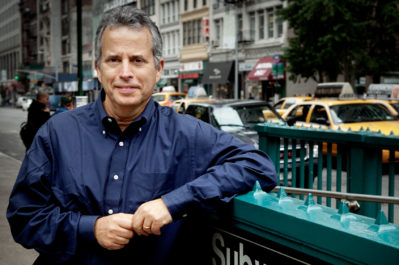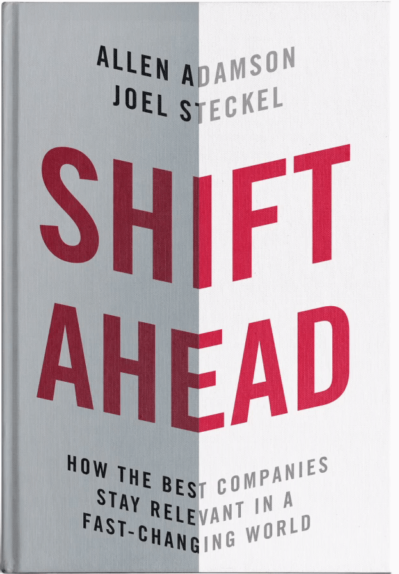In a world of abundant information and content, how can organizations compete for customers’ attention? In this episode of Mastering Innovation on Sirius XM Channel 132, Business Radio Powered by The Wharton School, guest Allen Adamson, author of Shift Ahead: How the Best Companies Stay Relevant in a Fast-Changing World, discussed various brand stories that have caused companies to either shift ahead or lag behind.
Adamson covered three key questions: Why do companies fall behind, and how can they recognize this? How can they anticipate and prevent this? And finally, how can they actually execute successful strategies? Adamson explained certain red flags to look out for, including the lack of actionable insights from data analysis, and the “golden handcuffs” constraint, in which new ventures are less profitable than existing ones. To help firms learn to counter these problems, he referenced examples like IBM and Hasbro, emphasizing the need to start early, focus, and play to the company’s strengths. Adamson particularly highlighted the changes in how companies craft a meaningful brand story in the digital age and how that can determine the success of the organization.
An excerpt of the interview is transcribed below. Listen to more episodes here.
Transcript

Nicolaj Siggelkow: One of the red flags that you noted is, “big on data, short on analysis.” I like that one. Tell us a bit more. Big data, obviously, is one of the keywords that everyone is bending around. What’s the red flag here?
Allen Adamson: Like anyone else, they’re collecting. Many organizations collect much more data, either intentionally or unintentionally, than they plan to. But, you need to have a culture that’s comfortable looking at that data and knows how to see the trees in the forest, how to actually use that data.
We had a great conversation with the CMO of Facebook, and he talked a lot about the culture at Facebook. They are into the numbers. They had the data, and so when they saw, five years ago or maybe more, that the number of people sharing pictures on Facebook was exponentially going up, it was not hard for them to make a bid for Instagram.
In fact, the street said, “Are you crazy spending that much?” But inside, they knew they had the data that said, “This is where the world is going. We need to shift for that.” Part of it is collecting data, but part of it is internalizing it in an organization, and then finally taking action on it.
“You need to have a culture that’s comfortable looking at that data and knows how to see the trees in the forest.” – Allen Adamson
Siggelkow: Right. Have you seen some pattern across companies who do this well? Every company wants to do that.
Adamson: If the data is being collected by the data folks or the marketing business folks, there’s a high risk that it’s not connected to the central nervous system. The only time people go into the data is when the sales numbers tip, and by then, it’s a lagging indicator. By the time the sales number starts sliding, it’s usually too late.
Siggelkow: Another red flag you have, which I really like, is this idea about competing on price, not differentiation. Maybe you could elaborate a little bit on that one.
Adamson: That goes back to some basic marketing theory. When you ask companies, “How’s your marketing? How’s your brand?” the typical response is, “Oh, our awareness is great. People know our name, and people recognize us.” Of course, awareness is important, but many of the companies fall into the problem of, “I know you, but you’re nothing special. You’re nothing different. If I know you fly to L.A., but so do three other airlines and they all have the same experience, then, of course, when it comes down to purchase, there’s no difference. They all fly the same 757s, and I’ll just take the cheapest fare.”
Oftentimes, there’s a false sense of security: “We’ve got great awareness, and everyone knows our jingle and our name.” I look at Citibank and often wonder, yes, it’s lovely that they named the stadium here in New York City. It’s Citi Field or the Citi Bike. If my bike broke, I might take Citi Bike a lot, but I’m not sure, when it comes to checking decisions, if I would take $10 more from my checking account at Citi because they give me a bike to ride once in a while or I get a hotdog at the Mets game.
Siggelkow: Let’s talk a bit more about brands. Have brands become more important or less important?
Adamson: There is, of course, lots of debate on the topic. The data that I’ve seen is that brands, if you think about it, are shortcuts to help people make decisions. As the world gets more complicated and as the world moves faster, I can’t take apart my computer, and certainly, I can’t put it back together once I take it apart, then determine what type of processor I want to put in, what type of chip is best, and what type of memory. I need to make, to some extent, a brand decision saying, “Which one helps me make the choice?”
In a world of increasing clutter, one dimension of brand says they are still, if they are differentiated and clear, great shortcuts and powerful ways to drive business, especially on a global basis. If the brand is only awareness and people don’t have any differentiation, in this transparent world, word-of-mouth is growing. You could have a great brand reputation, but if your word-of-mouth is being sucked into an undertow, it doesn’t matter if people have heard of you.
“Brands, if you think about it, are shortcuts to help people make decisions.” – Allen Adamson
Siggelkow: It seems like brands are being built differently nowadays. Is that right?
Adamson: Yes, it used to be top-down. In some ways, we’re going back to the future, to reference that old movie. Brands used to be built because you would ask your neighbor over the backyard fence, “What do you recommend?” Or, you’d ask the great tailor who you knew at the town store. Then, we went through this long period of, you didn’t talk to anybody. You sat on your couch, and somebody talked to you. Now, we’re returning to that. You need to build it from the bottom-up and the top-down. There are a number of marketers who say, “Allen, we really have no marketing budget, but all we really need is a video that will go viral. Can you just make one?”
“Sure,” I say, “If you buy me a lottery ticket that wins, I’m happy to make you a video.” In the world of so much content out there, getting your brand story across powerfully is harder and harder.
Siggelkow: Even just over the last five years, it has probably become much more difficult to reach everyone out there.
Adamson: But, as you know, strong brands and focus go hand-in-hand, and that also helps companies.
Siggelkow: My sense is that a peer-based reputation score is an alternative way to communicate at least a certain part of the brand. The brand, as the value of trust, can now be created in a somewhat different and potentially less expensive way.
“How do you win in social media? Everyone knows the answer to that: you only share extraordinary.” – Allen Adamson
Adamson: More and more companies are struggling to have something shareable. The strategy for social media is disarmingly easy. Everyone says, “How do you win in social media?” Everyone knows the answer to that, which is: you only share extraordinary. No one shares ordinary, but doing something extraordinary, from a product point of view, a service point of view, an experience, is more and more difficult. Certainly, it’s easier to be extraordinarily bad than extraordinarily good.
About Our Guest
Allen Adamson is Co-Founder and Managing Partner of Metaforce, a disruptive marketing and product consultancy which, unlike traditional firms, takes a multi-disciplinary channel-agnostic approach to marketing challenges. It was created to help leaders understand all the forces at work inside and outside their businesses in order to identify strategies yielding the highest returns. Once determining the best strategy, Metaforce’s consortium of partners, each industry experts in their fields, pivot to help clients brilliantly act on and execute customer experiences in market. Metaforce combines the best aspects of brand management, strategy, and experience consultancies to deliver solutions that ensure its clients shift ahead of the dramatic changes in the marketplace in order to meet fast-evolving customer needs.
Prior to this Adamson was Chairman of Landor Associates, a global communications and brand strategy consultancy. Under his leadership, the company partnered with a wide array of iconic brands, including Accenture, GE, Johnson & Johnson, FedEx, HBO, Marriott, MetLife, P&G, Sony, and Verizon. Additionally, he provided guidance for non-profit organizations including the 9/11 Memorial and Museum, the Central Park Conservancy, and the Council on Foreign Relations, among others. Before leading Landor, Adamson worked on both the agency and the “client side” of the industry. At Unilever he was a marketing executive across a number of major packaged goods brands. He also held senior management positions at Ogilvy & Mather and DMB&B.
Adamson received his BS from the S.I. Newhouse School of Public Communications at Syracuse University, and an MBA from New York University’s Stern School of Business. You can follow his Twitter, @adamsona.
Mastering Innovation is live on Thursdays at 4:00 p.m. ET. Listen to more episodes here.




